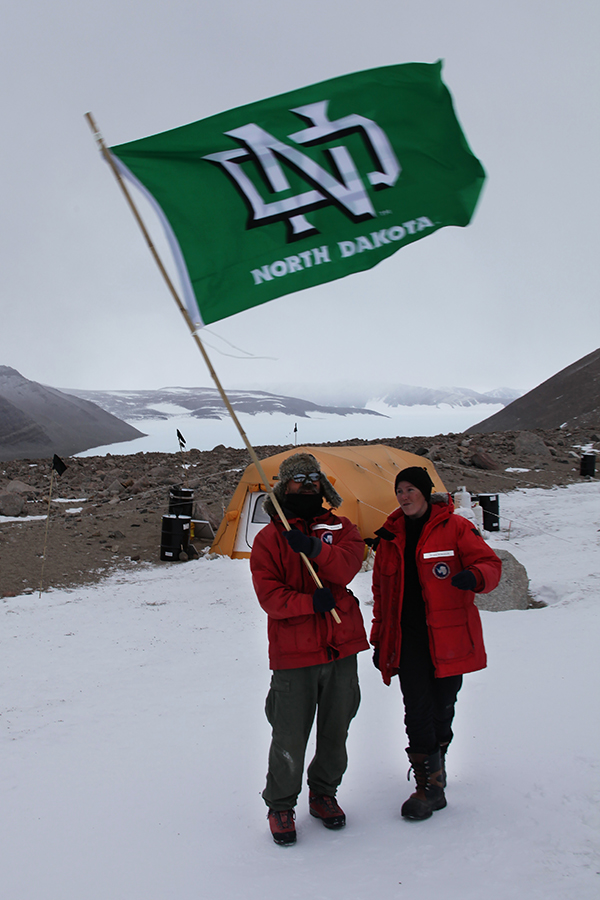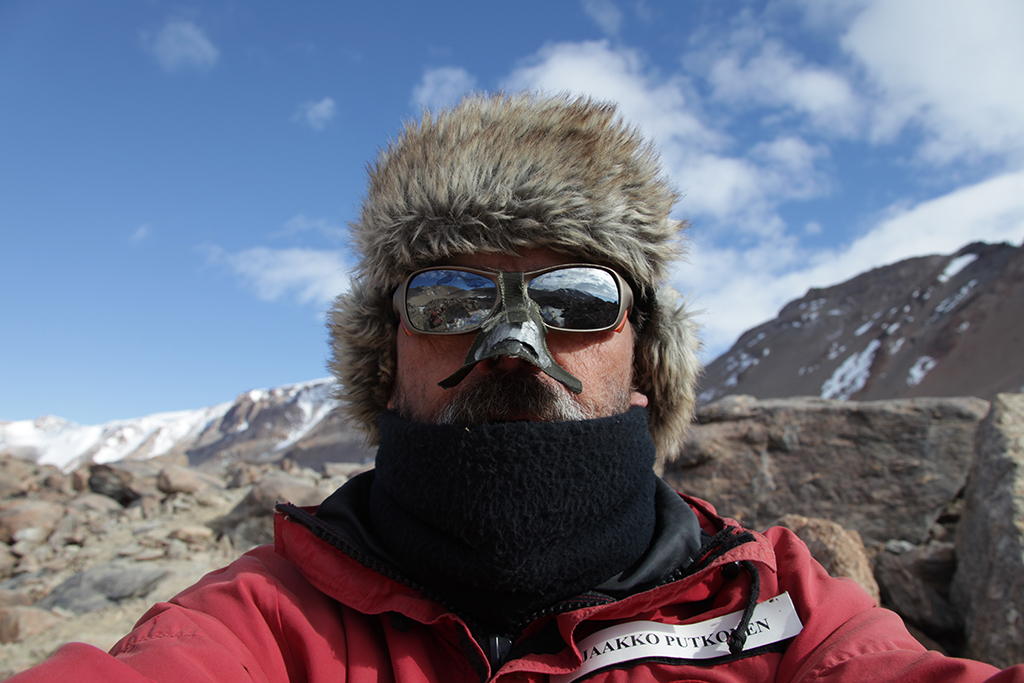UND geologist unearths world’s oldest ice
The 5-million-year-old ice samples may shed light on the Earth’s ancient climate

And you thought the crusty ice in your freezer was old.
A UND geologist has ice in his freezer that is potentially up to five million years old—which likely makes it some of the oldest ice ever discovered on the planet.
Jaakko Putkonen, associate professor of geology at UND’s Harold Hamm School of Geology and Geological Engineering, doesn’t actually store that ancient ice in his home freezer. Rather, it’s in a commercial freezer at the Energy & Environmental Research Center, on the east side of the UND campus. It comes out only occasionally if he needs to thaw out a chunk to get at the sand and dirt particles inside, in which case, he temporarily stores it in a small, office freezer.
Putkonen and a team of researchers in 2018 drilled 10-meter core samples of the ice found under dirt in the Ong Valley of the Trans-Antarctic Mountains. They now have data indicating the ice dates back 5 million years, and their research is popping up in big-name scholarly journals such as Nature. Along with a pair of researchers from the Berkeley Geochronology Center and Vanderbilt University, Putkonen and Marie Bergelin, then a UND geology graduate student but who now is doing post-doctoral research at the University of California-Berkeley, published a paper in July about the ice in The Cryosphere, a journal from the European Geosciences Union. The paper details the potential for the ice to reveal secrets about the Earth’s ancient climate.
“Ice is basically the best source of information that we have of the paleoclimate on Earth,” Putkonen told UND Today.
Bergelin is now back in the field in Antarctica, but she told UND Today by email that it was “really cool to have found some of the oldest ice on Earth,” adding that it’s a significant discovery for climate researchers.
“In order to evaluate its potential as a paleoclimatic archive, we first needed to figure out how old this ice mass is and understand its history, which is what we did for this project,” Bergelin said.

Paving the way for future researchers
The 10-meter-long cylindrical ice cores may open the doors for researchers around the world for a deeper understanding of the Earth’s ancient climate.
To reveal those secrets, researchers are examining the amount of CO2 contained in bubbles in the ancient ice. The dwindling amount of ice is housed at UND, and is shared with collaborators to analyze CO2, DNA, biological activity, and other indicators of past climate and environment.
Other researchers such as atmospheric scientists are taking on the task of CO2 analysis. Putkonen and Bergelin are geomorphologists; they study the processes of the landforms on the Earth’s surface. In Antarctica, they are interested in the evolution of the landscape—how much it changes or doesn’t change. Which makes the case of 5-million-year-old ice something of a mystery.
As a desert land, Antarctica does not get much snow. Exposed ice disappears from the continent at a rate of about 10 centimeters per year, Putkonen said. The ice either melts or sublimates, meaning it transforms directly from a solid state to vapor. This only happens, however, at certain temperatures and pressures. (Sublimation explains why old ice in your freezer sometimes appears as though it shrank.)

Why the Ong Valley, and what exactly was the discovery?
Putkonen said he chose the Ong Valley after poring over hundreds of aerial and satellite images of the 1000-mile-long mountain range. He said geological peculiarities in the air photo piqued his interest, and by relying on his experience he expected those peculiarities to indicate the presence of buried ice, in a place one would not normally find it. He visited the area prior to his most recent expedition; and after digging “lo and behold, we start finding ice.”
The research team uncovered two separate glacial advances buried under the dirt, one on top of the other. The one on the bottom was dated to be from 4 to 5 million years old, while the one on the top is about 3 million years old. Putkonen is still studying how the glaciers impact the formation of the landscape, as the top layer slowly sublimates.
Dating the samples
After a circuitous route back to UND (more on that later), Putkonen began the process of dating the ice. He did that, ironically, by melting it to get at the dirt and sand particles inside. Quartz crystals were extracted from the rocks and were washed to remove any impurities. Why quartz? At or near the Earth’s surface and over a period of millions of years the atoms in the mineral interacted with cosmic rays in ways that caused nuclear reactions within the mineral, resulting in the formation of new isotopes such as beryllium-10 and aluminum-26.
The cosmogenic isotopes, as they are called, have a decay rate that can be used to calculate the age of the sample. Putkonen said he sent about 30 samples (at $1,000 a pop) to an accelerator facility run by the National Science Foundation at Purdue University. Researchers there bombarded those samples to yield the concentration, and they calculated the age range of the samples and thus the ice in which they were contained.

Getting there and back
Drilling ice core samples in Antarctica means getting there while trying to keep the cores from melting on the way back. The trip to the Ong Valley isn’t exactly a trip to the supermarket. First, he and Bergelin flew to Los Angeles, and from there to Auckland and Christchurch, New Zealand, with Christchurch being a waypoint of sorts — it’s where commercial travel for Antarctica-bound travelers stops.
Instead, the journey from Christchurch continues on military supply planes operated by American National Guardsmen. McMurdo Station on Antarctica was the goal, though it wasn’t an easy journey from New Zealand – the captain of the plane informed Putkonen one of the engines had trouble and needed to be shut down. That meant turning around almost at the point of no return during the flight.
“This is pretty typical of this kind of travelling,” Putkonen said. “We sat eight hours on the plane, and you end up back in the same bed where you started in the morning. It’s really frustrating.”
And the flights don’t end at McMurdo, either. Once there, the researchers had to prepare their food and fuel, then transfer it from one Guard aircraft to another to fly further into the interior. There they broke down the pallets of supplies and repacked them into smaller stacks for transport by helicopter to the Ong Valley.
Spending five weeks in the valley calls for a lot of supplies, all of which must be handled with “Leave no Trace” rules similar to those of hiking through wilderness areas. That means hauling out every paper cup or plastic bag. Spilling things on the ground could lead to an environmental review, and if liquid fuel is spilled, the ground that soaks it up also needs to be hauled out in bags.
And according to Putkonen, that was the easy part. Drums and drums full of greywater needed to be hauled to the helicopter when it came time to leave, which made for some messy work.
“The problematic stuff is what comes out of people,” he said. “We also have to take that stuff out, and there was an amazing amount.”
The clock on the five-week-mission only started ticking when they arrived on the buried glacier. They camped in tents with no heat, and since it was summer in the southern hemisphere, no darkness. Putkonen said the constant daylight didn’t bother him.
“Well, I come from Finland, and it’s the same deal there in the summer,” he said.
Temperatures were about -10 degrees Celsius, or about 12 degrees Fahrenheit. Living for five weeks at that temperature – think of pitching your tent in your Grand Forks backyard in February, and staying there into March – means physical changes. Putkonen said it takes about five days to get used to the climate, and the cold-induced circulation changes made his hands and face puff up. Returning to McMurdo and its heated buildings meant a detransition period of about the same time.
The road home meant reversing that journey, though this time with two 10-meter ice cores (and with heaters in the helicopter and Guard aircraft turned off). On the return voyage, the cores were buried in snowbanks before arriving at McMurdo Station, where they went into a commercial freezer.
There they sat until the once-a-year cargo ship arrived to resupply the scientists who populate Antarctica. The cores were sent to California, where the NSF hired a freezer truck to transport them back to the researchers who had drilled them.
Being so far inland, UND was last on the list.
Putkonen said he was surprised at how professional the shipping service was. It was driven by an older couple who provided him with a printed slip that tracked the temperature of the truck’s freezer hour by hour; it had remained below 26 degrees Celsius.

Future drilling missions?
Bergelin said the team’s discovery, will likely inspire other researchers to travel to the Ong Valley to continue studying and understanding the ancient, buried ice mass. But she and Putkonen are looking at other areas to dig.
With the help of a UND geology graduate student, Putkonen said they have identified 22 likely places where there could be similar buried ice bodies in Antarctica. No one will know if ice lies under the dirt until someone puts a shovel to it, and then makes the arduous journey back to a university so any core samples can be dated. But that’s an opportunity Putkonen would relish.
“This is what I do,” he said. “I always tell students that I don’t do geology to sit in front of a computer. I do it to be able to go out into the field.”
-30-